Queens Park Rangers FC
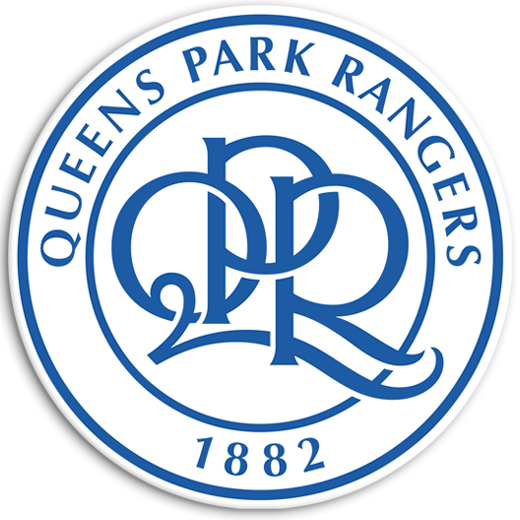
Details
- Name: Queens Park Rangers Football Club
- Nickname: The Hoops / The R's
- Founded: 1882
- Ground: Loftus Road Stadium
- Ground capacity: 18,489
History
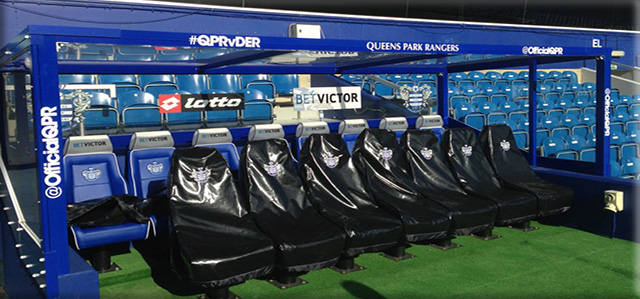
The club was formed in 1886, when a team known as St Jude's (formed in 1884) merged with Christchurch Rangers (formed in 1882). The resulting team was called Queens Park Rangers, because most of the players came from the Queen's Park area of North-West London. QPR became a professional team in 1889 and played their home games in nearly 20 different stadia (a league record), before permanently settling at Loftus Road in 1917 (although the team would briefly attempt to attract larger crowds by playing at the White City Stadium for two short spells: 1931 to 1933 and the 1962–63 season).
QPR were promoted as champions of Division 3 South in the 1947–48 season. Dave Mangnall was the manager as Rangers enjoyed four seasons in the Second Division, being relegated in 1951–52. Tony Ingham was signed from Leeds United and went on to make most ever league appearances for QPR (519). Prior to the start of the 1959–60 season saw the arrival of arguably the club's greatest ever manager, Alec Stock. The 1960–61 season saw QPR achieve their biggest win to date: 9–2 vs Tranmere Rovers in a Division 3 match. In time, Stock, with the advent as Chairman in the mid-60s of Jim Gregory helped to achieve a total transformation of the club and its surroundings.
In 1966–67, QPR won the Division Three championship and became the first Third Division club to win the League Cup on Saturday, 4 March 1967, beating West Bromwich Albion 3–2, (coming back from a two goal deficit). 42 years on, it is still the only major trophy that QPR have won. The final was also the first League Cup Final to be held at Wembley Stadium. After winning promotion in 1968 to the top flight for the first time in their history, Rangers were relegated after just one season and spent the next four years in Division 2.
Terry Venables joined from Spurs at the beginning of the 1969–70 season and Rodney Marsh was sold to Manchester City. During this time, new QPR heroes emerged including Phil Parkes, Don Givens, Dave Thomas and Stan Bowles. These new signings were in addition to home-grown talent such as Dave Clement, Ian Gillard, Mick Leach and Gerry Francis.
In 1974 Dave Sexton joined as manager and, in 1975–76 led QPR to the runners-up spot in the First Division, missing out on the Championship by a single point with a squad containing seven England internationals and internationals from the home nations.
After completing their 42-game season, QPR sat at the top of the league, one point ahead of Liverpool who went on to defeat Wolverhampton Wanderers to clinch the title. Wolves were relegated to the Second Division that same season. The late 1970s also saw some cup success with Rangers reaching the semi-finals of the League Cup and in their first entry into European football reached the quarter finals of the UEFA Cup losing to AEK Athens on penalties. Following Sexton's departure in 1977 the club eventually slipped into the Second Division in 1979.
1980s – 1990s
In 1980 Terry Venables took over as manager and the club installed a 'plastic pitch'. In 1982 QPR, still playing in the Second Division, reached the FA Cup Final for the only time in the club's history, facing holders Tottenham Hotspur. Tottenham won 1–0 in a replay. The following season 1982–83 QPR went on to win the Second Division championship and returned to English football's top division. After a respectable fifth place finish, and UEFA Cup qualification, the following year, Venables departed to become manager of Barcelona.
In 1988 the club had a new chairman, Richard Thompson. who at 24 was the Premier League's youngest ever chairman. Over the next seven years, various managers came and went from Loftus Road and the club spent many seasons finishing mid table but avoided relegation. The most successful season during this period was the 1987–88 season in which QPR finished fifth, missing out on a UEFA Cup campaign due to the ban on English clubs in European competition as a result of the Heysel Stadium disaster. They were also runners up in the 1986 League Cup, losing to Oxford United.
Gerry Francis, a key player in the 1970s QPR side who had proved himself as a successful manager with Bristol Rovers, was appointed manager in the summer of 1991. In the 1991–92 First Division campaign they finished mid-table in the league and were founder members of the new Premier League, finishing 5th, as top London club, in the 1992–93 inaugural season. Francis oversaw one of QPR's most famous victories, the 4–1 win at Old Trafford in front of live TV on New Years Day 1992. Midway through the 1994–95 season Francis resigned and very quickly became manager of Tottenham Hotspur and Ray Wilkins was installed as player-manager. Wilkins led QPR to an eighth place finish in the Premiership. In July 1995 the club's top goalscorer, Les Ferdinand, was sold for a club record fee of £6 million to Newcastle United.
QPR struggled throughout the following season and were relegated at the end of the 1995–96 season. QPR then competed in Division 1 until 2001 under a succession of managers. Gerry Francis returned in 1998, however the 2000–2001 season proved to be a disaster, and Francis resigned in early 2001.
2000 – present
Charismatic former player Ian Holloway became manager but was unable to stop Rangers from being relegated to England's third tier for the first time for more than thirty years. Following the 2003–2004 season QPR returned to Division 1 and struggled for consistent form over the next two campaigns before Holloway was suspended amidst rumours of his departure for Leicester City. A poor series of results and lack of progress at the club saw Holloway's successors Gary Waddock and later John Gregory (both former players) fail to hold on to the manager's job.
During this same period, QPR became embroiled in financial and boardroom controversy. Although the club had floated on the Alternative Investment Market in 1991, in 2001 it entered administration (receivership). A period of financial hardship followed and the club left administration after receiving a £10m high-interest emergency loan which continued to burden the club. Scandals involving the directors, shareholders and others emerged in 2005–06 season and included allegations of blackmail and threats of violence against the club's chairman Gianni Paladini.
In an unrelated incident QPR were further rocked by the murder of Youth Team footballer Kiyan Prince on 18 May 2006 and, in August 2007, the death of promising teenager and first-team player Ray Jones in a car crash.
Following this low point in the club's history as Rangers also faced mounting financial pressure, in the same month it was announced that the club had been bought by wealthy Formula One businessmen Flavio Briatore and Bernie Ecclestone (see Ownership and finances below). During the 2007–08 season, Rangers competed in the Football League Championship (see also: Queens Park Rangers F.C. season 2007-08). John Gregory's reign as manager came to an end in October 2007 after a string of poor results left QPR at the bottom of the Championship and he was replaced by Luigi De Canio until the end of the 2007–08 season.
Further investment followed in early 2008 as the club looked to push for promotion to the Premier League within four years, on the back of greater financial stability. On 14 May 2008 Iain Dowie was announced as the manager to begin the campaign to return Rangers to the top flight. However, on 24 October 2008 Iain Dowie was sacked after just fifteen games in charge of the club.
On 19 November 2008, QPR named former Portugal midfielder Paulo Sousa as their new first team coach. However, on 9 April 2009, his contract was terminated after he allegedly divulged confidential information without authority. On the same day as Sousa's sacking as QPR manager, Player/Coach Gareth Ainsworth was appointed as Player/Caretaker Manager of QPR for a second time. In June 2009 Jim Magilton was named as new manager of QPR.
Despite leading QPR to a good start to the 2009–10 season, a loss of form combined with an alleged head-butting incident with Hungarian midfielder Ákos Buzsáky saw the club further embroiled in controversy. Jim Magilton left the club by mutual consent on 16 December 2009, along with his assistant John Gorman. They were replaced by Paul Hart and Mick Harford on the next day. Less than a month and only 5 games after becoming manager at QPR, Paul Hart parted with the club on 14 January 2010. The reasons for his leaving the club were unstated.
On 30 April 2011, QPR secured promotion to the Premier League by winning the Championship with a 2–0 win over Watford. A subsequent FA investigation involving QPR's acquisition of Alejandro Faurlín threatened to deduct points from the side and put their promotion into jeopardy.
The investigation concluded on 7 May 2011, with QPR found to be at fault in two of the seven charges, and received a £875,000 fine. However, there were no points deducted by the FA, and QPR's promotion to the Premier League was secured.
In January 2012, club chairman Tony Fernandes appointed Mark Hughes as team manager 36 hours after the previous incumbent Neil Warnock was sacked. Following a tough start to his Loftus Road career and after a run of 5 straight home wins, Hughes and QPR escaped relegation despite a dramatic 3–2 defeat at Manchester City on the last day of the season.
On 23 November 2012, Mark Hughes was sacked on the back of a poor start to the 2012–13 season, having amassed only 4 points in 12 games and with the club languishing at the bottom of the Premier League despite significant financial investment in new players in the 11 months of Hughes' tenure. A day later, Harry Redknapp was confirmed as the new manager. On 28 April 2013, in a 0–0 draw against fellow relegation rivals Reading and with 3 games of the season to play, QPR were relegated from the Premier League down to the Championship after two seasons in the top flight.
During the 2013–14 season, QPR finished 4th in the Championship, and qualified for the play-offs where they defeated Wigan Athletic in the semi-finals. In the final against favourites Derby County on 24 May 2014, QPR won 1–0 with a goal by Bobby Zamora in the 90th minute to return to the Premier League.
On 3 February 2015, Redknapp resigned as manager of QPR. With an imminent knee operation, Redknapp felt that he could not give 100% to the job and that it would be better for someone else to take over as manager.
Following the resignation of manager Harry Redknapp on 3 February 2015, Ramsay was placed in temporary charge, with first Les Ferdinand, and then Kevin Bond. Ramsey's first competitive match as QPR manager was on 7 February 2015, losing to a 92nd minute, added-time winner, a 0–1 defeat to Southampton at Loftus Road. His first Premier League win came three days later, on the 10 February 2015, a 0–2 victory against Sunderland at the Stadium of Light, in QPR's first away victory and first away points of the season.
QPR were relegated from the Premier League following a 6-0 away defeat to Manchester City on May 10th 2015, with 2 games remaining.
On 19th May 2015, Queens Park Rangers appointed Chris Ramsey as their head coach on a permanent basis until 2018.
The team finished the season last, amassing only 30 points, and were relegated back to the Championship after only one season. After a poor start to the Championship, Chris Ramsey was sacked in November 2015 and former manager Neil Warnock returned to the hot seat in interim charge.
On 4 December 2015, Jimmy Floyd Hasselbaink was appointed the club's new manager on a rolling contract. Hasselbaink was sacked on 5 November 2016, just 11 months after being in charge.
Six days later QPR reappointed Ian Holloway who was in charge 10 years previously. Holloway left the club at the end of the 2017–18 season.
On 17 May 2018, QPR appointed former England manager Steve McClaren as manager. Despite promising first half of the season in which the team defeated the likes of Middlesbrough, Aston Villa and Brentford - 2019 would be a poor year with the team going on a 7 game loose streak.
Following a 2-1 defeat to relegation threatened Bolton, McClaren was sacked on 1 April 2019 after less than a year in charge.
On 8 May 2019, Mark Warburton was appointed as McClaren’s successor on a two-year deal.
Mark Warburton

The Facts
Queens Park Rangers Football Club (usually referred to as QPR) is an English professional football club based in White City, London who currently play in the Championship.
Their honours include winning the League Cup in 1967, being runners-up in the old First Division in 1975–76 and reaching the final of the FA Cup in 1982, where they lost 1–0 to Tottenham Hotspur in a replay after they drew 1–1 in the initial final match.
Queens Park Rangers Football Club were founded in 1882 after the merger of Christchurch Rangers and St.Judes Institute, and their traditional colours are blue and white.
In the early years after the club's formation in their original home of Queen's Park, games were played at many different grounds until finally the club settled into their current location at Loftus Road.
Owing to their proximity to other west London clubs, QPR maintain long-standing rivalries with several other clubs in the area.
The most notable of these are Chelsea, Fulham and Brentford, with whom they contest what are known as West London Derbies.
Outside London, QPR also traditionally share rivalries with Watford, Luton and Cardiff, although in recent years these fixtures have become less prominent.
For further information check out their Official website
Notable Players
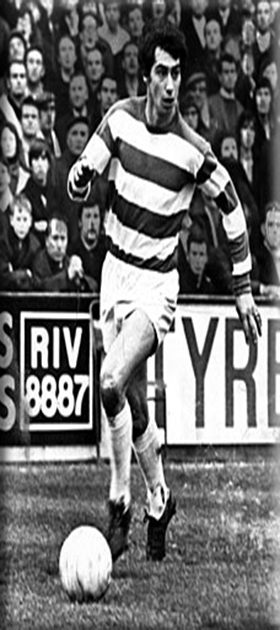
Dave Clement - 1965 to 1979
Notable Players
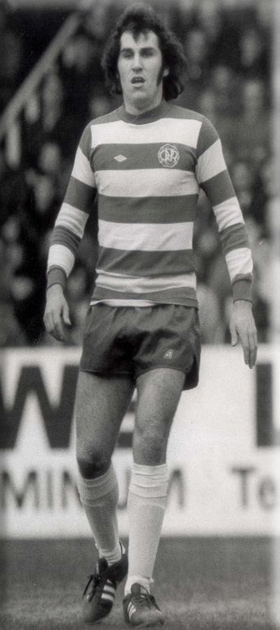
Gerry Francis - QPR 1968 to 1979
Notable Players
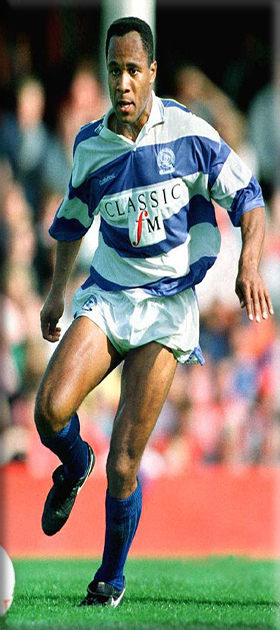
Les Ferdinand - 1987 to 1995
Notable Players
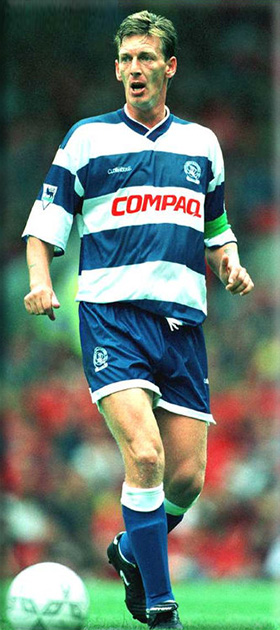
Alan McDonald - 1981 to 1997
Loftus Road Stadium
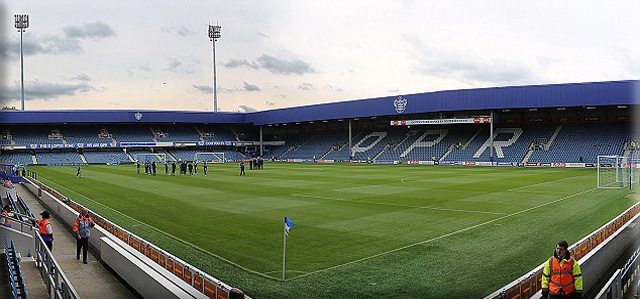
- Tennants: Shepherd's Bush F.C. (1904–1915)
- Queens Park Rangers F.C. (1917–31, 1933–62, 1963–present)
- London Wasps (Guinness Premiership) (1996–2002)
- Fulham F.C. (2002–2004)
- Capacity: 18,439 - Opened: 1904
The ground was first used on 11 October 1904 by Shepherd's Bush F.C., an amateur side that was disbanded during the First World War. QPR moved to Loftus Road in 1917, having had their ground at Park Royal commandeered by the army in 1915. At that time the ground was an open field with a pavilion. One stand from Park Royal was dismantled and re-erected forming the Ellerslie Road stand in 1919. This stand remained as the only covered seating in the ground until 1968 and was replaced in 1972. It had a capacity of 2,950.
QPR moved out of Loftus Road at the start of the 1931–32 season, moving nearby to White City Stadium, but after a loss of £7,000, the team moved back. In 1938 a new covered terrace for 6,000 spectators was constructed by a company called Framed Structures Ltd at the Loftus Road end taking the capacity up to 30,000. It cost £7,000 (with £1,500 donated by the QPR Supporters Club) and was opened by the Rt Hon Herbert Morrison, the leading Labour MP and future war time Home Secretary, at the match vs Crystal Palace on 29 October. The section of the terracing that was covered was concreted at this time with the uncovered section later concreted in 1945.
In April 1948, after winning the Third Division (South) championship, the club bought the freehold of the stadium plus 39 houses in Loftus Road and Ellerslie Road for £26,250. When the club's finances were under pressure in the late 1950s the houses had to be sold. On 5 October 1953 floodlights were used at Loftus Road for the first time for a friendly game against Arsenal. In the summer of 1966 the original floodlights were replaced by much taller floodlight pylons. In the summer of 1980 these in turn were replaced with the current floodlights.
QPR experimented once again with a move to White City Stadium in the 1962–63 season, but moved back to Loftus Road once more after only a single season. In the summer of 1968 the South Africa Road stand was constructed at a cost of £150,000 to replace the old open terracing. In 1972 a new stand was completed in Ellerslie Road, replacing the tin-roofed grandstand, and first used in the match versus Oxford United on 2 December 1972. The changing rooms and offices were moved to South Africa Road and the television gantry moved in the other direction.
The stadium's highest recorded attendance of 35,353 was in a game against Leeds United on 27 April 1974. The following summer the paddock of the South Africa Road stand was converted from terracing to seating with the installation of 4,600 seats, thus lowering the capacity of the stadium to the 31,002 present for the last home match of the 1975/6 season against Leeds United on 24 April 1976.
During the summer of 1981 an artificial pitch of Omniturf was installed at Loftus Road, the first such surface to be used in British professional football. The surface was not favoured by everyone, with QPR keeper Peter Hucker describing it as "basically a bit of carpet over two feet of concrete", and stated that as a goalkeeper, he strongly disliked diving onto it saying that "I'd have close to third degree burns because the pitch would totally rip the skin off." Rangers lost the first league match played on the new surface 1-2 versus Luton Town on 1 September 1981.
During the time that Loftus Road had the Omniturf pitch installed, QPR reached two cup finals and became Second Division champions, something that critics claimed was caused by the advantage the pitch presented, and QPR's home games in the 1984–85 UEFA Cup were played at Arsenal's Highbury Stadium. It was claimed that manager Terry Venables would let opposition teams train on the pitch when it was dry, and then deliberately dampen the pitch so that the ball played differently to what they expected at kick off. It was removed in April 1988 because of football legislation and replaced with grass. There were just three other league stadiums in the whole country with a plastic pitch, and by 1994 all of these had been ripped up.
Loftus Road Stadium, South Africa Road entrance.
New stands were opened at the School End in the summer of 1980 and one year later at the Loftus Road end. At the same time as the Loftus Road stand was built executive boxes were installed in the lower tier of the South Africa Road stand and the artificial pitch laid. The stadium capacity at this time was 27,000 and it was one of the most modern and advanced stadiums in Britain having been completely reconstructed over the 13-year period from 1968 to 1981. In the summer of 1994 the Loftus Road ground became an all-seater stadium with the construction of seating in the lower Loftus Road stand. The last match where home spectators were able to watch the match from terracing was on 16 April 1994 against Everton.
The owning company, also called Loftus Road, of QPR, London Wasps and the stadium itself, went into the red in the late 1990s only a couple of seasons after it was formed in 1996.In 2001, there were concerns that Queens Park Rangers and the stadium would need to be sold separately when the club went into administration. There was interest from commercial buyers and housing developers. A supporter's trust was set up to keep the club at Loftus Road, and to fight the suggested move out of the stadium and to Milton Keynes. One further suggestion was a merger between QPR and fellow London club Wimbledon, with the newly merged club playing at Loftus Road, but this idea was abandoned following the response from supporters. A £1 million payment by QPR's long time local rivals Fulham in 2002 helped to alleviate the financial problems in return for a ground sharing agreement while Craven Cottage was developed.
Loftus Road briefly became home to non-league football club Yeading as they faced Premiership club Newcastle United in the third round of the 2005 FA Cup. The decision was made as Yeading felt that their home stadium could not suitably segregate the fans. Despite holding out for fifty minutes, Yeading went on to lose the match 2–0.
 The future
The future
Following a number of years of uncertainty as to whether the club would expand the capacity of the stadium or relocate to a new site in the event of a return to the Premier League, it was announced by chairman Tony Fernandes on 28 November 2011 that the club was investigating the possibility of relocating to a new site in West London in order to build a bigger stadium. The current capacity of the stadium is 18,439.
This is not the first time that an owner has suggested moving out of Loftus Road, with director Antonio Caliendo suggesting a location near BBC Television Centre as a potential site for a new shopping and leisure development in March 2006,[19] and then QPR manager Luigi De Canio suggesting in 2008 that the team needs to leave the stadium in order to fulfil its ambitions.
In August 2013, QPR started discussions with Hammersmith and Fulham Council about moving into a new stadium, believed to be set for Old Oak Common, and soon after, in December, confirmed that they would be leaving Loftus Road for the short move across West London. However, in July 2014, these plans suffered a setback, with the current tenants at Old Oak - Car Giant - suggesting the club's plans were "speculative and presumptuous".
Structures and facilities
Loftus Road has a capacity of 18,439. Because of the size of the stadium, supporters find themselves close to the pitch compared to other stadiums. All four of the modern stands meet with no gaps, giving an overall impression of a tightly enclosed stadium. The School End is the stand reserved for away supporters, and all the stands have two tiers with the exception of the Ellerslie Road Stand.
The South Africa Road stand is the biggest of the four stands at the stadium. It is a two tier stand which includes The Paddocks and contains a row of boxes separating The Paddocks and the upper tier. It also houses the dugouts, changing rooms, suites, tunnel, offices, club shop, box office and press conference rooms. The Paddocks area is the cheapest in the ground, whereas the upper tier is the most expensive. The new exclusive W12 and C Clubs are located here.
The Ellerslie Road Stand at Loftus Road
The Loft is a two tier stand built in 1981 behind the goal and traditionally where most members and season ticket holders sit. This is the third most expensive stand to sit in. QPR generally attack this end in the second half because it is believed to be good luck. The police crowd observation box is located in this stand and it is home to the members' bar in the ground, The Blue and White Bar. A new colour scoreboard is located at this end, installed in Summer 2008, on the advertising boards between the upper and lower tiers.
The Ellerslie Road stand, rebuilt in 1972, is constantly renamed and sponsored, but QPR fans refer to it as the Ellerslie Road Stand. It is a single tiered stand and is the smallest in height, but not in noise and capacity. It is also the only stand not to be painted in blue and white hoops, instead it has "QPR" painted across it. It is home to the famous "R Block" where, along with the Loft's Q and P blocks sit QPR's partisan following. Most of the noise is generated from this stand, in addition to the Loft. This stand is a favourite of the fans because of the view and atmosphere. This is the second most expensive stand. It is also home to the commentary and television camera gantry.
At the west end of the ground is the School End built in 1980. 1,700 visiting supporters can be accommodated in 'The School End' upper tier; 1,300 additional lower tier seats are also allocated to visitors if demand is high enough. A new big screen was erected on the roof of the School End in the summer of 2008 which shows match highlights during the game plus adverts. This joined a new colour scoreboard which is located on the advertising boards between the middle and lower tiers.
Honours
- Division 1
- Runners-up: 1975–76
- Football League Championship
- Champions: 1982–83 - 2010–11
- Runners-up: 1967–68 - 1972–73
- Football League One
- Champions: 1947–48 - 1966–67
- Runners-up: 1946–47 - 2003–04
- FA Cup
- Runners-up: 1981–82
- League Cup
- Winners: 1966–67
- Runners-up: 1985–86
- FA Charity Shield
- Runners-up: 1908–09 - 1912–13

 01 - Jordan Pickford
01 - Jordan Pickford 02 - Nathan Patterson
02 - Nathan Patterson 04 - Mason Holgate
04 - Mason Holgate 10 - Iliman Ndiaye
10 - Iliman Ndiaye 12 - João Virgínia
12 - João Virgínia 15 - Jake O'Brien
15 - Jake O'Brien 16 - Abdoulaye Doucouré
16 - Abdoulaye Doucouré 19 - Vitalii Mykolenko
19 - Vitalii Mykolenko 29 - Jesper Lindstrøm
29 - Jesper Lindstrøm 31 - Asmir Begovic
31 - Asmir Begovic TBC - Armando Broja
TBC - Armando Broja TBC - Orel Mangala
TBC - Orel Mangala 63 - Žan-Luk Leban
63 - Žan-Luk Leban 65 - Matthew Apter
65 - Matthew Apter 84 - Coby Ebere
84 - Coby Ebere TBC - Kingsford Boakye
TBC - Kingsford Boakye Arsenal
Arsenal Aston Villa
Aston Villa Bournemouth
Bournemouth Brentford
Brentford Brighton
Brighton Chelsea
Chelsea Crystal Palace
Crystal Palace Everton
Everton Fulham
Fulham Ipswich Town
Ipswich Town Leicester City
Leicester City Liverpool
Liverpool Manchester City
Manchester City Manchester United
Manchester United Newcastle
Newcastle Nottingham Forest
Nottingham Forest Southampton
Southampton Tottenham Hotspur
Tottenham Hotspur West Ham United
West Ham United Wolves
Wolves


















